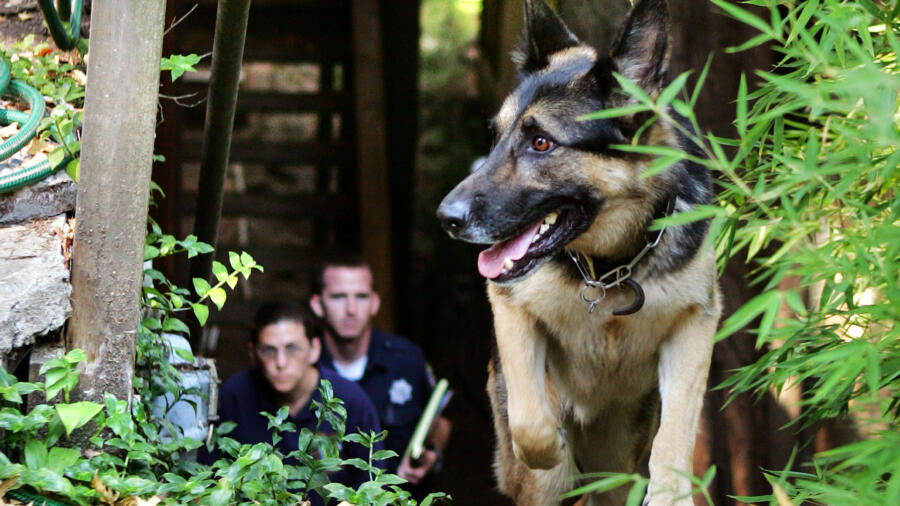“We were coming out of the swamp, approaching a copse of trees and heavy brush… His tail tensed into a tight curl… I knew that curl. Solo was in cadaver scent,” Cat Warren, a cadaver dog handler and professor at North Carolina State University, writes in her book What the Dog Knows.
At that moment, Warren admits to feeling dizzy from an adrenaline surge as a body appeared, facedown, shirtless, mired in mud, about 30 feet from her and her canine partner, Solo.
Across the United States, cadaver dogs are used in a variety of crime investigations, ranging from missing persons cases to murder. Some experts (and studies) say they are about 95 percent accurate at their craft and can smell remains up to 15 feet underground, making them invaluable law enforcement team members.
When 2-year-old Caylee Anthony went missing in 2008, for example, a cadaver dog detected the scent of human remains in two locations: the trunk of her mother Casey Anthony’s car and a corner of her grandparents’ backyard. Her remains were later found inside a laundry bag in a wooded area near the Anthony family’s house.
A&E True Crime spoke to Warren about her work as a cadaver dog handler and how these well-trained animals play a quintessential role in solving crimes.
What is the role of a cadaver dog in investigating a crime?
The role of a cadaver dog—and the dog’s handler, because it really is a team—is to search areas where there is some kind of evidence or possibility that someone, or a piece of someone, may be located. Most often, it’s a person who’s deceased.
Well-trained cadaver dogs can cover areas that are too difficult for people to cover. I live in North Carolina, for example, and our underbrush is awful. Cadaver dogs can locate the scent of human remains or narrow down an area. There are also times when the scent of human remains is so faint or old that it really is only the dog’s amazing nose that can indicate there’s something there.
[Stream episodes of America’s Top Dog on A&E’s site and apps.]
In a sense, they’re like forensic investigators, good detectives and ground penetrating radar. They’re a really important part of the puzzle that can be an enormous help.
How did you become a cadaver dog handler?
Becoming a cadaver dog handler was a combination of being cursed and blessed. We got a German shepherd puppy named Solo, who turned out to be a singleton. Singletons can often be little doggie sociopaths. They can be aggressive [to other dogs] and sometimes don’t like to relate to [them]. Some are the same with people.
This pup was an amazing and a smart dog, but he was a challenge. I kept thinking, ‘What can I do to help this dog live his best life?’ He had an excellent nose and was obsessed with going out in the grass and tracking the last person who was in the yard.
I took him to a trainer I knew, and she suggested training him as a cadaver dog. I found the idea oddly appealing, partly because my father was a biologist. I also grew up in the country with hunters and fishermen, so the idea of training him to do this work didn’t haunt me or freak me out. It sounded like a useful thing to do.
Solo took to it like a duck to water. He was a super bright, hard-driving, intelligent dog. I made so many mistakes with him, and he just didn’t care. He was resilient and trained me as much as I trained him. I worked with him for more than eight years.
The majority of cadaver dog handlers are volunteers. Why do people volunteer in this capacity, and how do they get involved?
The very first cadaver dogs were actually used by the Connecticut State Police in the ’80s. They were often multipurpose dogs—they might be somebody’s patrol dog, but also be brought out for cases where somebody was missing and presumed dead.
These days, many of the people involved are volunteers. That’s partly because law enforcement agencies are sort of stretched tight, and they don’t need a cadaver dog every day. It’s also because search and rescue has a long history in the United States of being a volunteer institution. Search and rescue people are devoted to their community. They are [frequently] outdoors and like to be ground pounders. If a child goes missing, for example, they can deploy quickly. Cadaver dog teams are kind of a branch of search and rescue.
What kind of training do cadaver dogs go through? How do they learn to track the scent of human remains?
It’s on the dog how much training they need because each dog is unique. And it’s not [just] about learning to recognize the scent of human remains. It’s also having all these other skills that are important alongside, such as being environmentally tough and able to work through distractions.
The dogs need to know the difference between a deceased animal and deceased human and go in places with all those distracting scents. Teaching them to locate the scent of human remains can be a question of a few months or longer, because they’re learning to recognize a complex set of smells.
We now have proof that dogs can help locate [everyone from] the very long deceased, as far back as the Iron and Bronze Ages, to those who are freshly deceased.
It’s not just blood that a dog is trained to track. A dog needs to learn all these different volatile organic compounds. For instance, teeth can be enormously important in helping to identify someone’s remains. Yet, the scent coming off a tooth is so faint. Plus, you’re asking a dog to follow a specific person’s scent, and not another person’s scent. Human remains are super complicated.
What are the qualities that make a good cadaver dog?
What I love about cadaver dogs is that you don’t have to talk about a particular breed. I’ve seen really good boxers and border collies that are cadaver dogs. What you’re looking for is a dog that isn’t distracted easily, that finds the work appealing and that is able to do it for a long time. I’ve seen cadaver dogs that are 11 years old and still very effective. With cadaver searches, you want a dog that doesn’t get bored after five minutes and decide to flip the paw. Again, they must have great noses. This combination means that you can take a happy, confident dog and funnel its energy into this particular kind of work.
As a cadaver dog handler, are you required to file reports? What about testifying in court?
Reports are important because they can come up in court. Even training records are important if you’re called to testify in a case where your dog alerted to the scent of human remains. A good defense attorney is going to ask for your training records.
Training should involve failure. You want to prove that the dog has become stronger and better. So, your training records should reflect weaknesses and how you addressed them.
Your role is doing your best job at handling the dog and searching the areas that you’ve been asked to search and report back. When you file a report, you give exact locations, specify the time started and time finished and track wind and temperature, among other details.
Is there a particular case that stands out for you where one of your dogs played a key role in finding a victim?
There are several cases that have stayed with me. Without divulging gender, age or any other details, we worked on one case for a couple of years. Finding the victim brought a sense of relief and great satisfaction.
Related Features:
Dogs Behind Bars: What Inmates Get From Training Service Animals


